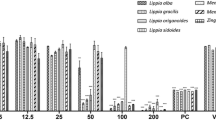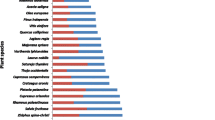Abstract
In vitro (larval development assay) and in vivo studies were conducted to determine possible direct anthelmintic effect of ethanolic and aqueous extracts of Spigelia anthelmia towards different ovine gastrointestinal nematodes. The effect of extracts on development and survival of infective larvae stage (L3) was assessed. Best-fit LC50 values were computed by global model of non-linear regression curve fitting (95% confidence interval). Therapeutic efficacy of the ethanolic extracts administered orally at a dose rate of 125, 250, and 500 mg/kg, relative to a non-medicated control group of sheep harbouring naturally acquired infection of gastrointestinal nematodes, was evaluated in vivo.
The presence of S. anthelmia extracts in the cultures decreased the survival of L3 larvae. The LC50 of aqueous extract (0.714 mg/ml) differ significantly from the LC50 of the ethanolic extract (0.628 mg/ml) against the strongyles (p < 0.05, paired t-test). Faecal egg counts on day 12 after treatment showed that the extract is effective, relative to control (one-way analysis of variance [ANOVA], Dunnett’s multiple comparison test) at 500 mg/kg against Strongyloides spp. (p < 0.01), 250 mg/kg against Oesophagostomum spp., Trichuris spp. (p < 0.05), and 125 mg/kg against Haemonchus spp. and Trichostrongylus spp. (p < 0.01). The effect of the doses is significant in all cases, the day after treatment is also extremely significant in most cases, whereas interaction between dose and day after treatment is significant (two-way ANOVA).
S. anthelmia extract could, therefore, find application in the control of helminth in livestock, by the ethnoveterinary medicine approach.

Similar content being viewed by others
References
Ademola IO, Fagbemi BO, Idowu SO (2004) Evaluation of the anthelmintic activity of Khaya senegalensis extract against gastrointestinal nematodes of sheep: in vitro and in vivo studies. Vet Parasitol 122:151–164
Adegoke EA, Akinsanya A (1968) Studies of Nigeria medicinal plants: I-A preliminary survey of plant alkaloid. J West Afr Sci Assoc 13:13–33
Athanasiadou S, Kyriazakis I, Jackson F, Coop RL (2000) Effect of short term exposure to condensed tannins on adult T. colubriformis. Vet Rec 146:728–732
GraphPad Software (2004) San Diego, CA, USA, http://www.graphpad.com
Hubert J, Kerboeuf D (1992) A microlarval development assay for the detection of Anthelmintic resistance in sheep nematode. Vet Rec 130:442–446
Iwu MM (1993) CRC Handbook of African medicinal plants. CRC Press, Boca Ratch, pp 213–214
Ministry of Agriculture, Fisheries and Food (1971) Manual of Veterinary Parasitological Techniques, Reference Book 418. HMSO, London, p 159
Ogunsusi RA (1979) Termination of arrested development of trichostrongyles of sheep in Northern Nigeria. Res Vet Sci 26:189–192
Ogunsusi RA, Eysker M (1979) Inhibited development of trichostrongylids of sheep in Northern Nigeria. Res Vet Sci 26:108–110
Author information
Authors and Affiliations
Corresponding author
Rights and permissions
About this article
Cite this article
Ademola, I.O., Fagbemi, B.O. & Idowu, S.O. Anthelmintic activity of Spigelia anthelmia extract against gastrointestinal nematodes of sheep. Parasitol Res 101, 63–69 (2007). https://doi.org/10.1007/s00436-006-0444-0
Received:
Accepted:
Published:
Issue Date:
DOI: https://doi.org/10.1007/s00436-006-0444-0




